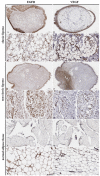EGFR, VEGF, and angiogenesis promote the development of lipoma in the oral cavity
- PMID: 37194849
- PMCID: PMC10208286
- DOI: 10.1590/0103-6440202305117
EGFR, VEGF, and angiogenesis promote the development of lipoma in the oral cavity
Abstract
This study aimed to detect, quantify and compare the immunohistochemical expression of EGFR and VEGF and microvessel count (MVC) in oral lipomas, and to correlate the findings with clinical and morphological characteristics of the cases studied. The sample consisted of 54 oral lipomas (33 classic and 21 non-classic) and 23 normal adipose tissue specimens. Cytoplasmic and/or nuclear immunohistochemical staining of EGFR and VEGF was analyzed. The angiogenic index was determined by MVC. Cells were counted using the Image J® software. The Statistical Package for the Social Sciences was used for data analysis, adopting a level of significance of 5% for all statistical tests. A statistically significant difference in EGFR immunoexpression (p=0.047), especially, between classic lipomas and normal adipose tissue. There was a significant difference in MVC between non-classic lipomas and normal adipose tissue (p=0.022). In non-classic lipomas, only VEGF immunoexpression showed a significant moderate positive correlation (r=0.607, p=0.01) with MVC. In classic lipomas, the number of EGFR-immunostained adipocytes was directly proportional to the number of VEGF-positive cells, demonstrating a significant moderate positive correlation (r=0.566, p=0.005). The results suggest that EGFR, VEGF, and angiogenesis participate in the development of oral lipomas but are not primarily involved in the growth of these tumors.
Lipomas são as neoplasias mesenquimais benignas mais comuns, no entanto sua etiopatogenia ainda permanece desconhecida. Dessa forma, essa pesquisa teve como objetivo detectar, quantificar e comparar a expressão imunoistoquímica do EGFR, VEGF e contagem microvascular (MVC) dos lipomas orais, relacionando-os com as características clínicas e morfológicas dos casos estudados. A amostra foi composta por 54 lipomas orais (33 clássicos e 21 não clássicos) e 23 casos de tecido adiposo normal. A análise da expressão imunoistoquímica de EGFR e VEGF foi fundamentada na marcação citoplasmática e/ou nuclear. O índice angiogênico foi avaliado por meio da MVC. A contagem de células foi realizada utilizando software IMAGE J®. Os dados obtidos foram analisados no software Statistical Package for Social Science. O nível se significância de 5% foi adotado para os testes estatístico. A análise da imunoexpressão das proteínas revelou para o EGFR diferença estatisticamente significativa (p=0,041) entre o lipoma clássico e o tecido adiposo normal. Houve diferença significativa na MVC entre lipomas não clássicos e tecido adiposo normal (p=0,022). Nos lipomas não clássicos, apenas a imunoexpressão de VEGF apresentou correlação do tipo moderada, positiva e significativa (r=0,607; p=0,010) em relação a MVC. Ademais, nos lipomas clássicos foi percebido que os adipócitos imunomarcados para EGFR estiveram diretamente proporcionais a imunoexpressão de VEGF, apresentando correlação do tipo moderada, positiva e estatisticamente significativa (r=0,566; p = 0,005). Com base nos resultados, pode-se sugerir que o EGFR, VEGFR e MCV participam do desenvolvimento nos lipomas orais, contudo, não estão primariamente envolvidos no crescimento tumoral dessas neoplasias.
Conflict of interest statement
The authors declare no competing interest.
Figures



References
-
- Lee JB, Choi HJ, Son ET, Kim JH. A Research of Soft Tissue Lipoma Genesis Factor With Immunohistochemical Analysis. J Craniofac Surg. 2017;28(4):871–876. - PubMed
-
- Juliasse LE, Nonaka CF, Pinto LP, Freitas Rde A, Miguel MC. Lipomas of the oral cavity: clinical and histopathologic study of 41 cases in a Brazilian population. Eur Arch Otorhinolaryngol. 2010;267(3):459–465. - PubMed
-
- Trento GDS, Stringhini DJ, Rebellato NLB, Scariot R. Extra-Oral Excision of a Buccal Fat Pad Lipoma. J Craniofac Surg. 2017;28(3):e226–e227. - PubMed
MeSH terms
Substances
LinkOut - more resources
Full Text Sources
Research Materials
Miscellaneous

